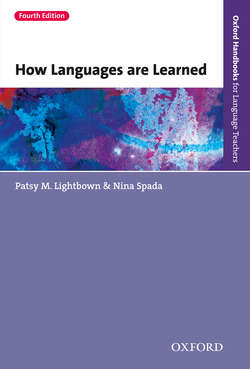How Languages are Learned 4th edition

Реклама. ООО «ЛитРес», ИНН: 7719571260.
Оглавление
Nina Spada. How Languages are Learned 4th edition
ACKNOWLEDGEMENTS
PREFACE TO THE FOURTH EDITION
INTRODUCTION
Before we begin…
1. LANGUAGE LEARNING IN EARLY CHILDHOOD
Preview
First language acquisition
The first three years: Milestones and developmental sequences
The pre-school years
The school years
Explaining first language acquisition
The behaviourist perspective
The innatist perspective
Interactionist/developmental perspectives
Language disorders and delays
Childhood bilingualism
Summary
Suggestions for further reading
2. SECOND LANGUAGE LEARNING
Preview
Learner characteristics
Learning conditions
Studying the language of second language learners
Contrastive analysis, error analysis, and interlanguage
Developmental sequences
Possessive determiners
More about first language influence
Vocabulary
Pragmatics
Phonology
Sampling learners’ language
Summary
Suggestions for further reading
3. INDIVIDUAL DIFFERENCES IN SECOND LANGUAGE LEARNING
Preview
Research on learner characteristics
Intelligence
Language learning aptitude
Learning styles
Personality
Attitudes and motivation
Motivation in the classroom
Identity and ethnic group affiliation
Learner beliefs
Individual differences and classroom instruction
Age and second language learning
The critical period: More than just pronunciation?
Intuitions of grammaticality
Rate of learning
Age and second language instruction
Summary
Suggestions for further reading
4. EXPLAINING SECOND LANGUAGE LEARNING
Preview
The behaviourist perspective
Second language applications: Mimicry and memorization
The innatist perspective
Second language applications: Krashen’s ‘Monitor Model’
The cognitive perspective
Information processing
Usage-based learning
The competition model
Language and the brain
Second language applications: Interacting, noticing, processing, and practising
The sociocultural perspective
Second language applications: Learning by talking
Summary
Suggestions for further reading
5. OBSERVING LEARNING AND TEACHING IN THE SECOND LANGUAGE CLASSROOM
Preview
Natural and instructional settings
In natural acquisition settings
In structure-based instructional settings
In communicative instructional settings
Observation schemes
Classroom comparisons: Teacher–student interactions
Classroom comparisons: Student–student interactions
Corrective feedback in the classroom
Questions in the classroom
Ethnography
Summary
Suggestions for further reading
6. SECOND LANGUAGE LEARNING IN THE CLASSROOM
Preview
Proposals for teaching
1 Get it right from the beginning
2 Just listen … and read
3 Let’s talk
4 Get two for one
5 Teach what is teachable
6 Get it right in the end
Assessing the proposals
Summary
Suggestions for further reading
7. POPULAR IDEAS ABOUT LANGUAGE LEARNING REVISITED
Preview
Reflecting on the popular ideas: Learning from research
Conclusion
GLOSSARY
BIBLIOGRAPHY
Отрывок из книги
We wish first to thank the readers who responded so positively to the earlier editions of this book. With each edition, we have benefited from suggestions and feedback offered by colleagues and students. Our thanks to Ahlem Ammar, Alexander Ary, Philippa Bell, Luz Celaya, Laura Collins, Maria Fröhlich, Randall Halter, Zhaohong Han, Marlise Horst, Jim Hu, Phillip Hubbard, Youjin Kim, Roy Lyster, Alison Mackey, Kim McDonough, Shawn Loewen, Paul Meara, Imma Miralpeix, Vicki Murphy, Carmen Muñoz, Heike Neumann, Howard Nicholas, Paul Quinn, Katherine Rehner, Mela Sarkar, Raquel Serrano, Younghee Sheen, Wataru Suzuki, and Yasuyo Tomita. Leila Ranta, and Jude Rand made essential contributions to the first edition.
At Oxford University Press, we owe a debt to Henry Widdowson for his early encouragement and to Cristina Whitecross, who was our editor for the first three editions. We are grateful to Catherine Kneafsey, Julia Bell, Hazel Geatches, and Ann Hunter who have worked with us through the development of this new edition. We thank the English Speaking Union for conferring the 1993 Duke of Edinburgh book prize for Applied Linguistics on the book.
.....
The challenge of learning complex language systems is also illustrated in the developmental stages through which children learn to ask questions.
There is a remarkable consistency in the way children learn to form questions in English. For one thing, there is a predictable order in which the ‘wh- words’ emerge (Bloom 1991). ‘What’ is generally the first wh- question word to be used. It is often learned as part of a chunk (‘Whassat?’) and it is some time before the child learns that there are variations of the form, such as ‘What is that?’ and ‘What are these?’.
.....